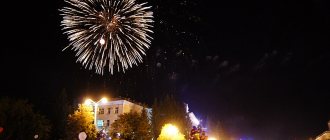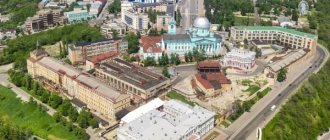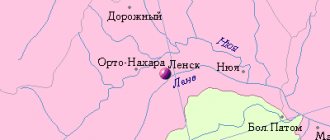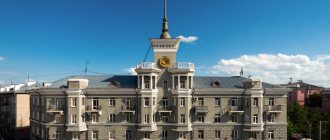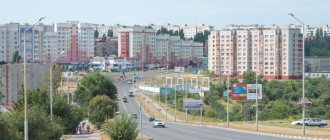The Sverdlovsk region is located on the border of Europe and Asia, in the zone of the northern and middle parts of the Ural Mountains, rich in minerals. It is natural resources that have become the basis for the development of the region and are the most important support for today’s economic development. In terms of size, the region is in 17th place in the all-Russian ranking: its area is 194,307 km². This is almost 4 times larger than the territory of the Moscow region and almost 16 times smaller than the area of the Republic of Sakha, the largest subject of the Russian Federation.
List of largest cities in the Sverdlovsk region
There are 47 cities and almost 1,850 small rural settlements in the Sverdlovsk region. However, there is only one metropolis - the capital of the region and the Urals Federal District, Yekaterinburg. Another 11 cities boast a size of more than 100 km², but in terms of population they lag significantly behind the million-plus city of Yekaterinburg, where 1,468,833 people live. The basis for the development of human settlements and their transformation in the course of history from small villages into large formations is industrial development based on the extraction and processing of minerals.
The largest cities in the Sverdlovsk region by area include:
- Ekaterinburg - 468 km².
- Serov - 418 km².
- Lesnoy - 360 km².
- Kachkanar - 317 km².
- Krasnoturinsk - 309 km².
- Zarechny - 299 km².
- Nizhny Tagil – 297 km²
- Verkhnyaya Tura - 236 km².
- Tavda - 148 km².
- Kamensk-Uralsky - 144 km².
Nizhny Tagil
The next largest city in the Sverdlovsk region is Nizhny Tagil. Its population is 355.5 thousand people. This is the most important cultural and industrial center not only of the Sverdlovsk region, but also of the entire Urals. The economic indicators are simply amazing. The number of goods sold produced in the city in manufacturing industries alone exceeds 130 billion rubles per year. Surprisingly, according to this statistical indicator, Nizhny Tagil is a leader in the entire region, ahead of even Yekaterinburg.
The largest enterprises are the Nizhny Tagil Metallurgical Plant, Uralvagonzavod, and OJSC Uralkhimplast. These industries employ a significant number of local residents.
Ekaterinburg is a metropolis and an industrial center of global importance
Yekaterinburg is the recognized capital of the Urals, the largest city in the region and the region, with an area of 468 km². It occupies fourth place in the list of the largest cities in Russia, second only to two capitals and Novosibirsk. Its urban agglomeration, which is also one of the three most successfully developing post-industrial ones, occupies the same position in the all-Russian ranking of the largest. In the capital of the region there are such important organizations as:
- Administration of the Urals Federal District;
- 35 authorities of various territorial affiliations;
- Presidium of the regional branch of the Russian Academy of Sciences;
- headquarters unit of the Central Military District.
Ekaterinburg plays a vital role not only in the Russian but also in the world economy; it is included in the ranking of 600 most important cities on the planet from an economic point of view, accounting for 60% of the global gross domestic product. Leading industry segments include:
- metallurgy;
- metal processing;
- military industrial complex;
- heavy engineering;
- chemical industry;
- food production;
- light industry;
- creation of optical, electronic and electrical equipment;
- printing;
- instrumentation and others.
There are about 220 significant enterprises in the city, most of which are engaged in the manufacturing industry. In second place in terms of contribution to the economy are retail trade enterprises, of which more than 4,000 are registered. In the capital of the Urals, there is Koltsovo Airport, and a branch of the Trans-Siberian Railway passes through the city. Public transport is well developed here: in addition to buses and minibuses, there are metro, trams and trolleybuses. In addition, the regional center is included in the list of ten Russian cities with the largest vehicle fleet. Such a developed transport infrastructure and industry cause serious harm to the environment. In terms of air pollution, Yekaterinburg is included in the all-Russian anti-rating. Despite the abundance of manufacturing enterprises, exhaust gases cause the greatest harm: they account for more than 90% of harmful emissions.
Yekaterinburg has given the world many talented and famous people. Among the most famous natives is Boris Yeltsin; one of the most visited city attractions, the Yeltsin Center, is also associated with his name. Also from here are the storyteller Bazhov, singer Yuri Gulyaev, and the legendary rock groups Nautilus, Chaif and Agatha Christie. The local theaters are considered one of the best, and museums present a variety of exhibitions: from the history of literature to an amazing collection of minerals.
Pervouralsk - a city of metallurgists
Pervouralsk has a population of 123,000. It, like Nizhny Tagil, is located among mountain ranges. Rivers flow through the city and there are ponds. The landscapes are very attractive for tourists who love mountains. The settlement was founded on the site of a mining operation. Then a chemical plant, a pipe plant and a metal rolling plant were created. The metallurgical industry developed dynamically, which contributed to the influx of workers. Pervouralsk lies at the intersection of railway tracks. The Trans-Siberian Railway passes through it. Neighboring cities are connected by a network of electric trains. In addition to active recreation, residents of Pervouralsk and its guests can spend time in museums, cinemas, visit zoos and forest parks.
Serov is a large production center
Serov is only in fifth place in terms of population with 97,366 inhabitants, but in terms of area it ranks second with 418 km². Like the leader of the rating, it is an important center of industry, thanks to the development of which it gained life. It is believed that more than a thousand years ago there was a settlement of the Mansi, the indigenous local population, on this territory. Over time, Russians began to move into the region, having discovered rich mineral deposits, and the Mansi left the region, moving to the northern lands.
In 1894, a settlement was founded in these places, designed to meet the needs of large-scale construction: for the production of steel rails, a plant was built, which was named Nadezhdinsky: later the entire expanded village began to be called that. As a result, in 1919 it received city status, and twenty years later it was renamed in honor of the hero of the USSR Anatoly Serov. The city's economy is formed by the engineering and metallurgical industries. The city-forming enterprises include:
- "Nadezhda Metallurgical Plant" (named after Serov);
- Serov Mechanical Plant - production of industrial tools;
- The Serov Ferroalloy Plant is the second largest in terms of production volume after an enterprise in the same segment from Chelyabinsk.
Kamensk-Uralsky
Kamensk-Uralsky occupies a special place in the list of cities in the Sverdlovsk region. This is another large-scale cultural and industrial center in the Middle Urals, home to almost 170 thousand people.
It is among the top ten largest transport railway junctions in the country. This is where many federal highways and highways intersect. The settlement on the site of Kamensk-Uralsky was founded back in 1682 by direct decree of the Russian Tsar Fyodor Alekseevich, but it acquired the status of a city only in the 20th century, in 1940.
Now the city is going through difficult times, it was even included in the list of Russian single-industry towns with a critical economic situation.
Three quarters of the city’s economy comes from the four largest enterprises - the Sinarsky Pipe Plant, RUSAL, and Metallurgical. Companies in the non-ferrous and ferrous metallurgy, mechanical engineering, and food industries are actively developing in the city.
Lesnoy is a large city located in a closed area
Surprisingly, the third largest city of Lesnoy with an area of 360 km² is only on the 13th place in the list of the largest cities by the number of inhabitants. This is explained simply: the formation is a closed territory, since the Elektrokhimpribor plant, which works with uranium, is located here. The factory and then the settlement were built by Gulag prisoners. In the first years of its existence, it was called Sverdlovsk-45: only in 1994 the name was renamed.
In this regard, there are no significant attractions in Lesnoy, but the infrastructure for local residents is well developed. There are about 500 companies in various segments of the economy, as well as 3 universities, among which there is one that corresponds to the profile of the city - a branch of the Scientific Research Nuclear University MEPhI.
Novouralsk
There is a fairly large settlement on the list of closed cities in the Sverdlovsk region - Novouralsk. It is home to about 81.5 thousand inhabitants.
The city was formed in 1941 after a light alloy plant began to be built in the vicinity of the modern settlement. In 1954, Novouralsk received city status. Remains one of 40 closed cities in Russia and one of ten owned by Rosatom.
The largest enterprises are the Ural Electrochemical Plant and the Novouralsk Instrument Plant. In recent years, the construction of multi-storey comfortable residential buildings has been actively developing in the city. It is noteworthy that most construction sites are located directly in the very center of the city. In addition, it is one of the largest energy centers located in the Northern Urals. Agriculture plays a significant role in the local economy.
Kachkanar is large in area, but not in numbers
Kachkanar ranks fourth in area - 317 km², and fifteenth in number of inhabitants - 38,996 people. Like many others in the region, it arose in the 19th century thanks to the wealth of the Ural mineral resources: platinum and gold were discovered nearby.
This led to the emergence of many mining settlements. On the basis of one of them, in the fifties of the last century, a village appeared, created for workers of the Kachkanar group of iron ore deposits. The formation of the Kachkanarsky mining and processing plant occurred during the same period: the enterprise, declared an all-Union construction site, today acts as a city-forming enterprise. Kachkanar gives the impression of a well-groomed, clean and green town. Most of the attractions are monuments and memorials, including those to the Liquidators of Nuclear Disasters, as well as the heroes of the Second World War and the Afghan War. Some of the most beautiful buildings are the Old and New Temples of the “Seeking the Lost” icon.
Description of the region
The Sverdlovsk region is a subject of the Russian Federation, part of the Ural Federal District. It borders with the Perm Territory, Khanty-Mansi Autonomous Okrug, the Komi Republic, Tyumen, Chelyabinsk, Kurgan regions, and Bashkotorstan. The administrative center is Yekaterinburg, which was formerly called Sverdlovsk. Hence the name of the region itself. The border between Europe and Asia runs near Yekaterinburg.
This is the largest region of the Urals. The area of the Sverdlovsk region is almost 200 thousand square kilometers. The territory includes the north of the Ural Mountains and part of the West Siberian Plain.
The climate in the region is continental. Summers are hot, with temperatures up to 30 degrees Celsius, winters are moderately cold. In January - on average -17-20 degrees. The territory is mainly covered with forests, 82 percent of them.
Nevyansk - bears the title of the first factory city in history
In second position in the ranking of small towns is Nevyansk, whose area is 17 km². It owes its appearance to Peter the Great, who in 1701 ordered the construction of an iron and iron smelting plant in the Urals. Due to the fact that the settlement began to form around the built enterprise, Nevyansk can be called the first factory city in world history. Also, its development is connected with another famous person: businessman Nikita Demidovich Antufiev. The emperor taught him a lesson in managing the new plant, not suspecting that soon the enterprising Nikita would achieve unprecedented heights, becoming the founder of the Demidov family.
The current city limits were recorded in 2006, when the population was 25,600. In Nevyansk and the neighboring town of Cementnoye there are five large factories operating in the following areas:
- mechanical engineering;
- pipe processing;
- cement production;
- production of dry mixtures.
In addition, the small town is considered a cultural center of Old Believer icon painting of the mining type. The most famous landmark is the Ural Leaning Tower of Nevyansk, built in 1721 as a family building of the Demidovs, marking their receipt of the title of nobility. Scientists are still debating whether something went wrong during construction, or as a result of subsequent flooding of the basements, but the tower tilted 3° 16′ at its greatest point. The structure is a symbol of the city and was even minted on a commemorative coin of the Central Bank in 2007.


